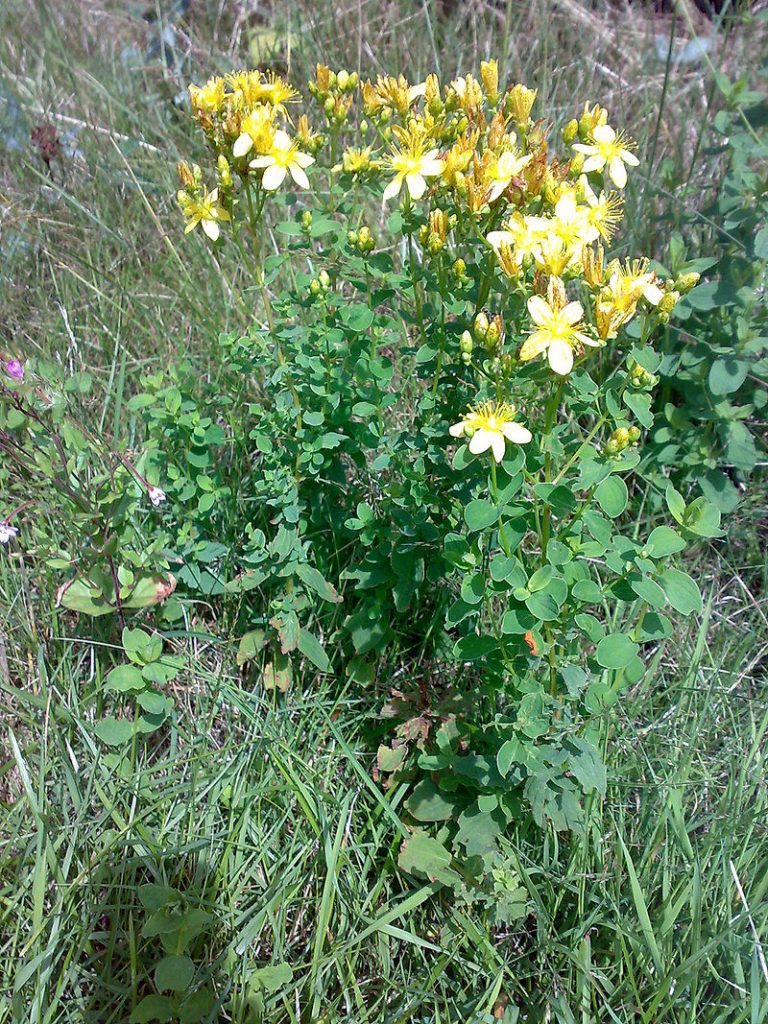
Common St. John’s wort is a herbaceous perennial known for its medicinal properties from ancient times. It is native to Europe, western Asian and North Africa where it occurs in a wide variety of habitats including pastures, meadows, rangelands, woodlands, open forests, natural clearing, moist ravines, abandoned fields, roadsides, and ditches. The root system consists of one or many aerial crowns attached to a system of vertical and lateral roots. The vertical roots reach a depth of two to five feet white the lateral roots are 1.2″ to 3″ deep and produce new crowns. Plants generally grow one to three feet tall but can reach five feet, and have one to many erect often reddish stems that are woody at the base, branched in the upper half ,and have pale green to yellow-green oblong or linear round tipped leaves. The leaves are attached directly to the stem and have scattered translucent dots created by the presence of glands. The flowers are 3/4 inch across and appear in terminal clusters of 25-100 all summer. They have five yellow petals with black dots on the edges and give way to round seed pods with pointed tips. Photo Credit Bjoertvedt-Wikimedia-Commons
According to legend common St. John’s wort grew under Jesus’s cross. The tiny glands on its leaves produce a blood-red oil which was known as “the blood of Christ”. Another tradition says that the glands on the leaves symbolize Christ’s bloody sweat that appeared as Christ prayed in the garden at Gethsemane during the Agony in the Garden. According to Luke 22.44 (NIV), “And being in anguish, he prayed more earnestly, and his sweat was like drops of blood falling to the ground.” Still other stories note that the plant first blooms on the birthday of John the Baptist, June 24, and that it bleeds on the day in August when he was beheaded. The plant is believed to be most potent if harvested on June 24 and can be used to treat various nervous disorders such as bed wetting, gastric problems, and uterine cramps. More recently it has been used as an antibiotic and anti depressant. The oil has a warm relaxing effect on muscles and is used for massage.
Common St. John’s wort is considered an invasive weed in many places spreading by seed and creeping roots. It grows in full sun to part shade in average, medium moist, well-draind acid soil (but tolerates less) in USDA Hardiness zones 5-9. Propagation is by seed, cuttings and division. Plants are generally healthy and have no significant diseases or pests.
The genus name, Hypericum, is from the Greek word hypereikon and derived from hyper, meaning above, plus eikon meaning picture. The plant was believed to keep evil spirits away and the flowers of some species were placed above pictures to ward off evil at the ancient midsummer festival on June 24 which later became the feast of St. John. The specific epithet, perforatum, is the Latin word meaning having or appearing to have small holes and refers to the holes that the Devil pierced in the leaves with a needle in revenge for people using the flowers to repel evil spirits. The holes are actually translucent glands.